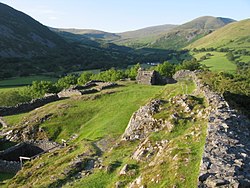Castell y Bere
| Castell y Bere | ||
|---|---|---|
|
Aerial view of the ruin |
||
| Creation time : | 13th Century | |
| Castle type : | Hilltop castle | |
| Conservation status: | ruin | |
| Geographical location | 52 ° 39 '29.5 " N , 3 ° 58' 17.4" W | |
|
|
||
Castell y Bere is a ruined castle in Gwynedd in Wales . It is located near Abergynolwyn in the Mid Wales Mountains on a rocky plateau in the upper Dysynni Valley at the foot of the Cader Iris. The ruin, protected as a Scheduled Monument , is an outstanding example of a castle built by the Welsh princes.
history
The castle was probably built around 1221 by Llywelyn ab Iorwerth , Prince of Gwynedd . Llywelyn had taken over the administration of Meirionnydd again in 1221 , which had previously been administered by his eldest son Gruffydd . The remote castle was located on what was then the southern border of the Principality of Gwynedd at the foot of the Cader Idris and originally served to protect the trade route to Dolgellau . The castle was later expanded by Llywelyn ap Gruffydd , among other things, he had the entrance reinforced by a gate kennel . During the conquest of Wales by Edward I , Dafydd ap Gruffydd , the brother and successor of Llywelyn ap Gruffydd, withdrew to Castell y Bere. The castle had become one of the last major Welsh strongholds after the capture of Dolwyddelan Castle in January 1283. Before the English invading army under Otton de Grandson , Roger Lestrange and William de Valence could lock the castle in April, Dafydd fled on to Dolbadarn Castle . The Welsh castle commander, Cynfrig ap Madog, surrendered Castell y Bere on April 25th in the face of the English superiority after ten days of siege. The English left a small garrison behind to repair the castle. Edward I visited the castle in 1284 and gave an English settlement near the castle a royal charter , but the borough hardly developed due to its remote location .
Madog ap Llywelyn besieged the castle during the Welsh Revolt of 1294 . An English attempt at relief failed and during the siege all the buildings of the inner castle burned down, so that the Welsh presumably could conquer the castle. After the revolt was put down, the heavily damaged castle and borough were abandoned by the English.
In 1851 the first excavations took place on the site of the forgotten ruin. Today the ruin is looked after by Cadw and is freely accessible.
investment
The high, narrow building site caused the irregular, elongated layout of the castle. The elongated inner castle was built between two D-shaped towers typical of Welsh castles. At the highest point of the castle was a rectangular keep , the endangered north side was protected by an additional round tower. In contrast to the strong towers and compared to English castles of the same age, however, the curtain wall was weak. The residential and farm buildings were built onto the inside of the north wall; the main living rooms were probably located in the south-western tower. The main gate was on the west side and was protected by a moat carved into the rock and a gate fence.
Excavations have shown that the castle was luxuriously equipped for the time with ornate tiles, stone carvings and stained glass windows. Today only the remains of the foundation walls of the towers and walls remain from the castle.
literature
- Adrian Pettifer: Welsh Castles. A Guide by Counties . Boydell, Woodbridge 2000, ISBN 978-0-85115-778-8 , pp. 113-115
Web links
Individual evidence
- ↑ Ancient Monuments: Castell y Bere. Retrieved October 13, 2014 .
- ↑ Visit Midwales: Castell y Bere. (No longer available online.) Formerly in the original ; accessed on October 13, 2014 . ( Page no longer available , search in web archives ) Info: The link was automatically marked as defective. Please check the link according to the instructions and then remove this notice.
- ↑ Coflein: CASTELL-Y-BERE; CASTELL Y BERE. Retrieved October 13, 2014 .
- ^ Paul R. Davis: Castles of the Welsh Princes . Y Lolfa, Talybont 2007. ISBN 978-0-86243-970-5 , p. 43


